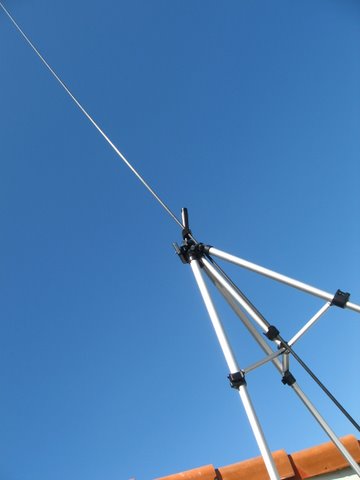The Aluminium/graphite tube 20m vertical.
The idea all started when I was shopping for material for a portable hexbeam design. Something very lightweight yet sturdy had to be used to support a 20m hex. Fibreglass telescopic fishing poles works for maybe the higher bands, but on 20m, the turning radius of the entire construction is such that fibreglass rods are not sturdy enough. This is when I stopped by a few hobby shops and came across some Aluminium/graphite tubes. The though that these tubes can be made into radiating antenna elements was very attractive because it immediately create a few more ideas about verticals and other portable style antennas.
There is of course a wealth of information and products available for the vertical antenna enthuisiast - amongst others the buddypole, TWA antennas, etc. I wanted to experiment with a simple 20m vertical, and this is what I came up with.
My first experiments focussed on very easy to deploy vertical configuration, in the form of a quater wave vertical. These Al tubes have very thin walls and pieces slide together with matching inner stubs, making for a clean, strong joint. I found that the 1/4" outer diameter to be rigid enough to easily stand on it's own up to the required 20m quater wave vertical of around 16'



Notice how this lightweight camera tripod is holding up a fullsize 20m quater wave vertical.
(Of course having no wind helps)
Contest weekends are great for antenna experimentation. It allows for the antenna builder to have a field day assembling and testing antennas and giving away Q's as the rest of the world point their monstIR beams our way. ARRL SSB DX Contest 2009 was no exception, and while 20m and 40m was crowded with dx, I used the opportunity to test my kite-tube vertical. While some QRP (2W) contacts were easy, some longer distances required a little more power. Propagation was not too bad - and this certainly helped things along.
The Al/graphite tubes ship in a variety of wall thickness, inner/outer diameter sizes and you have to shop till you find what will work in your application. My first test was simply to get a self-standing full-size 20m quater wave vertical on the air. The key with tubes is to ensure a good electrical connection between the sections. I did this by means of an inner sleeve from Al, which ensures electrical connection between tubes. Some experimentation was needed to get this right, and this part of the project has much room for improvement.
The on-air reports compared favorably with a wire vertical dipole, I put up in the same location. I was suitably impressed by the light-weight (these tubes are meant to fly kites, and are really light weight) and ease of snapping these tubes together to get on the air wihtin a matter of minutes. An old camera tripod came in handy as a make-shift antenna support.

The 1/4" (24" sections) Aluminium-graphite tubes snap together nicely with an inner-sleeve connecting tube.
While the ideas of Shock-cord tubes and telescopic whips are certainly not new, I liked the way this project turned out, especially given the pricetag of around $20 for a full 16 feet of tubing. The next project will focus on the use of carbon-fibre (not Al/graphite) tubes for hex-beam spreaders. Their ultra-lightweight may just make a truly portable quick-assemble back-pack style monoband hex-beam a reality.